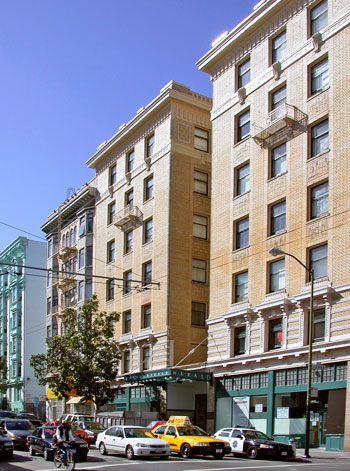National Register of Historic Places in San Francisco
Herald Hotel
308 Eddy Street Between Jones and Leavenworth
Built 1910
The Herald Hotel, designed by Alfred Henry Jacobs in the fashionable Renaissance Revival style, was a harbinger of the coming importance of the area west of Union Square as a major downtown hotel district after the 1906 Earthquake and Fire.
At seven stories, with 150 rooms and 97 baths, the Herald Hotel was one of the tallest and largest hotels built in the Tenderloin after the 1906 Earthquake and Fire. The Tenderloin was developed because of its location which was close to transportation, shopping, and theaters on Market Street and around Union Square and to accommodate hordes of tourists at 1915 Pan-Pacific Exposition.
Between 1907 and 1928 about fifteen hotels were built in the blocks contained by Taylor, Jones, Turk, and Ellis Streets. Of these only one, at ten stories, exceeded the Height of the Herald. (It was built in 1926 on the northeast corner of Turk and Jones.)
The Herald is also important for its use of a steel frame instead of the less expensive masonry bearing wall system that was the norm. Important features were the imposing lobby with three skylights of patterned, leaded glass.
The architect, Alfred Henry Jacobs, was born in San Francisco in 1882 and died here in 1954. He attended the University of California at Berkeley, the Massachusetts Institute of Technology, and the Ecole des Beaux Arts in Paris.
Jacobs best known existing building is the Curran Theater, but two other theaters, now demolished, were among the largest on the west coast when they were built. The first, the California Theater at 799 Market had a seating capacity of 3000 which made it the largest west coast theater in 1917. The somewhat later Granada Theater had a capacity of 3500.
In addition to these and other commercial buildings, Jacobs designed many private homes.
Adapted from the NRHP Nomination Form
